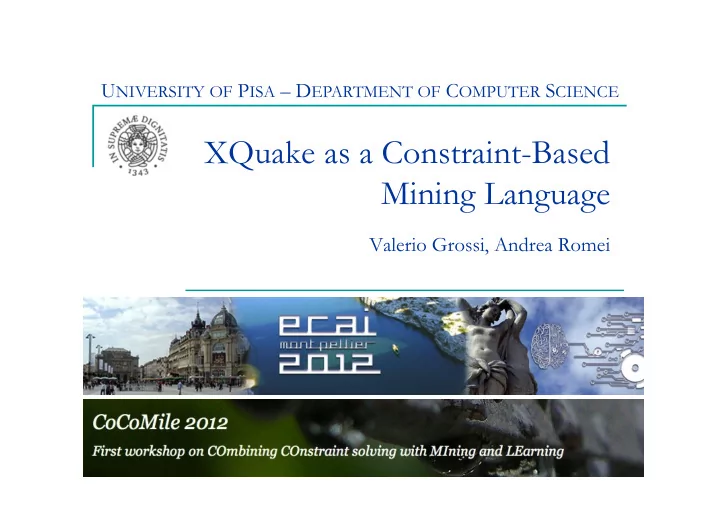

U NIVERSITY OF P ISA – D EPARTMENT OF C OMPUTER S CIENCE XQuake as a Constraint-Based Mining Language Valerio Grossi, Andrea Romei
Motivation and objective Das Bild kann zurzeit nicht angezeigt werden. � The amount of information coding XML data is growing � Systems for storing and querying XML data exist � Systems supporting DM features out of XML data are still missing � Our goal is to mine XML data according to the principles of the inductive databases theory (IDBs) � We give the main intuition that is behind a constraint-based mining language out of XML data 2 2
XQuake at a glance • XQuake is a language/system that extends XQuake XQuery with data mining features • Applications can use XQuery for simple data XQuery manipulation/querying or for control structures Raw data DM models • According to the IDB, data and mining models are …. stored in a native XML DB • Data mining is performed where the data is stored (i.e. no data transformation/manipulation) Native XML DB 3 3
XML-based vs. Relational-based Mining views, XQuake Atlas, DMQL, MineRule, … XQuery SQL Raw data Raw data DM models DM models …. …. Native XML DB Relational DB 4
Mining constructs (1) � XQuake admits several operators for pre-processing, mining and post-processing � Each mining operator is made up of a combination of base constructs. � The syntax is an adaptation of the XQuery syntax � The output result is always an XML sequence � Base constructs include: � Data and models iterators � Data/model binder � Constraints specification � Output constructor 5 5
Mining constructs (2) Data Iterator Model Data/model Constraints Output Iterator binder Preproc. X X Mining X X Model X X X X application Model X X X X evaluation Filtering X X 6 6
Main idea (1) � XQuake supports only simple constraints � E.g. «extract association rules having two items in the antecedent and the item ‘bread’ in the consequent» � We aim at integrating domain-specific constraints � How to represent the background knowledge? � How to express the constraint? � How to maintain the closure principle? � Our solution consists in � Representing the background knowledge with the aid of an ontology (RDF/OWL) � Expressing constraints directly via XQuery predicates A built-in function library is used to query the ontology � 7
Main idea (2) � The result is in an integrated environment in which all mining entities are represented via XML Closure Native XML DB Closure of XQuake Closure 8
A simple example of use (1) A domain expert investigates for a future promotional campaign � during the holidays (MBA) The goal is to study the relation between the most frequent drinks promoted at � Easter, and the most frequent cakes promoted at Christmas in the past Input data: XML transactions Domain knowledge: OWL document 9
A simple example of use (2) � We aim at extracting association rules having the following form: � Where: � EasterDrink (resp. ChristmasCake) is the class of items that are drinks (resp. cakes) having an Easter (resp. Christmas) promotion � AnyItem is the entire set of distinct items 10
A possible implementation (1) � XQuery is employed for querying and reasoning with OWL and RDF ontologies � A built-in function library is used to navigate and to query the ontology 11
A possible implementation (2) � An XQuake construct can be defined to extract association rules satisfying the given constraint � The local:hasRec(…) function is directly used inside the mining operator 12
Final Remarks (1) � Flexibility � As far as the modification of the domain knowledge A built-in library is employed to traverse the ontology � � As far as the introduction of different kinds of constraints An XQuery predicate is employed to express constraints � � Closure principle � Data, mining models and the background knowledge are XML documents � XQuery (extended) is used to represent the KDD process 13
Final Remarks (2) � Future work � Finalizing the implementation of the built-in XQuery library used to navigate the ontology � Exploiting domain-specific constraints for different kinds of models E.g. clusters and sequential patterns � 14
Recommend
More recommend